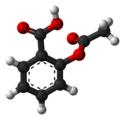ଆସ୍ପିରିନ
 | |
 | |
| Clinical data | |
|---|---|
| Pronunciation | acetylsalicylic acid /əˌsiːtəlˌsæl[invalid input: 'ɨ']ˈsɪl[invalid input: 'ɨ']k/ |
| Synonyms | 2-acetoxybenzoic acid acetylsalicylate acetylsalicylic acid O-acetylsalicylic acid |
| AHFS/Drugs.com | monograph |
| MedlinePlus | a682878 |
| data |
|
| Pregnancycategory |
|
| Routes ofadministration | Most commonly by mouth, also rectal, lysine acetylsalicylate may be given intravenously or intramuscularly |
| ATC code | |
| Legal status | |
| Legal status |
|
| Pharmacokinetic data | |
| Bioavailability | 80–100%[୨] |
| Protein binding | 80–90%[୧] |
| Metabolism | Liver, (CYP2C19 and possibly CYP3A), some is also hydrolysed to salicylate in the gut wall.[୧] |
| Elimination half-life | Dose-dependent; 2–3 hours for low doses, 15–30 hours for large doses.[୧] |
| Excretion | Urine (80–100%), sweat, saliva, feces[୨] |
| Identifiers | |
IUPAC name
| |
| CAS Number | |
| PubChem CID | |
| IUPHAR/BPS | |
| DrugBank | |
| ChemSpider | |
| UNII | |
| KEGG | |
| ChEBI | |
| ChEMBL | |
| PDB ligand | |
| ECHA InfoCard | 100.000.059 |
| Chemical and physical data | |
| Formula | C9H8O4 |
| Molar mass | 180.157 g/mol |
| 3D model (JSmol) | |
| Density | 1.40 g/cm3 |
| Melting point | 135 °C (275 °F) |
| Boiling point | 140 °C (284 °F) (decomposes) |
| Solubility in water | 3 mg/mL (20 °C) |
SMILES
| |
InChI
| |
| (verify) | |
ଆସ୍ପିରିନ (ଇଂରାଜୀ ଭାଷାରେ ଆସ୍ପିରିନ/Aspirin, ରାସାୟନିକ ନାମ ଆସେଟାଇଲ ସାଲିସାଲିକ ଏସିଡ/acetylsalicylic acid ବା ଏଏସଏ/ASA) ଏକ ପ୍ରକାର ଔଷଧ ଯାହା ପ୍ରଦାହ, ଯନ୍ତ୍ରଣା ଓ ଜ୍ୱର ନିବାରଣ ନିମନ୍ତେ ଦିଆଯାଏ ।[୩] କାୱାସାକି ଡିଜିଜ, ପେରିକାର୍ଡ଼ାଇଟିସ (pericarditis) ଓ ରିଉମାଟିକ ଜ୍ୱର ଇତ୍ୟାଦି ରୋଗରେ ଏହା ନିର୍ଦ୍ଦିଷ୍ଟ ଭାବରେ ଦିଆଯାଏ । ହୃଦ୍ଘାତ ଆରମ୍ଭ ହେବା ସଙ୍ଗେ ସଙ୍ଗେ ଆସ୍ପିରିନ ଦେଲେ ମୃତ୍ୟୁ ସଙ୍କଟ କମିଯାଏ । ଉଚ୍ଚ ସଙ୍କଟ ଥିବା ଲୋକଙ୍କର ହୃଦ୍ଘାତ, ସ୍ଟ୍ରୋକ ଓ ଥ୍ରୋମ୍ବସ (blood clots) ରୋଗମାନଙ୍କର ପ୍ରତିରୋଧ ନିମନ୍ତେ ଦୀର୍ଘକାଳୀନ ଆସ୍ପିରିନ ଦିଆଯାଏ ।[୩] ଆସ୍ପିରିନ ଦେଲେ କୋଲୋରେକ୍ଟାଲ କର୍କଟ ଭଳି କେତେକ କର୍କଟ ରୋଗମାନଙ୍କର ସଙ୍କଟ କମିଯାଏ ।[୪] ଜ୍ୱର ଓ ଯନ୍ତ୍ରଣା ନିମନ୍ତେ ଦେଲେ ଏହି ଔଷଧର କାର୍ଯ୍ୟ ୩୦ ମିନିଟ ମଧ୍ୟରେ ଆରମ୍ଭ ହୋଇଯାଏ ।[୩]
ଏହି ଔଷଧ ଯୋଗୁ ପେଟ ଗୋଳମାଳ (upset stomach) ଭଳି ସାଧାରଣ ପାର୍ଶ୍ୱ ପ୍ରତିକ୍ରିୟା ଦେଖାଯାଏ । ଅଧିକ ପାର୍ଶ୍ୱ ପ୍ରତିକ୍ରିୟା ମଧ୍ୟରେ ପାକସ୍ଥଳୀ ଘାଆ, ପାକସ୍ଥଳୀ ରକ୍ତସ୍ରାବ ଓ ଆଜ୍ମା ଅଧିକ ହେବା ଦେଖାଯାଏ । ମଦ୍ୟପାନ ଓ କେତେକ ଔଷଧ ଯେପରିକି ନନ୍ସ୍ଟିରଏଡାଲ ଆଣ୍ଟିନଫ୍ଲାମେଟରି (nonsteroidal anti-inflammatory drug) ବା ଆଣ୍ଟିକୋଆଗୁଲାଣ୍ଟ (blood thinners) ସେବନ କଲେ ଓ ବୟସ୍କ ଲୋକଙ୍କର ରକ୍ତସ୍ରାବ ସଙ୍କଟ ଅଧିକ ରହେ । ଗର୍ଭାବସ୍ଥାର ଶେଷ ଭାଗରେ ଆସ୍ପିରିନ ଦେବାକୁ ସୁପାରିସ କରାଯାଏ ନାହିଁ । ରେ ସିଣ୍ଡ୍ରୋମ ହେବା ସମ୍ଭାବନା ଥିବାରୁ ସଂକ୍ରମଣ ଥିବା ପିଲାଙ୍କୁ ଆସ୍ପିରିନ ଦିଆଯାଏ ନାହିଁ । ଅଧିକ ଡୋଜ ଦେଲେ ଟିନାଇଟସ ହୁଏ । ଅନ୍ୟାନ୍ୟ ଏନଏସଆଇଡି ଭଳି ଏହା କାମ କରିବା ସହ ପ୍ଲାଟେଲେଟର କାର୍ଯ୍ୟବିଧି ଅବରୋଧ କରିଦିଏ ।[୩]
ଅତି କମରେ ପ୍ରାୟ ୨୪୦୦ ବର୍ଷ ଧରି ଔଷଧୀୟ ଗୁଣ ଥିବା ଯୋଗୁ ଆସ୍ପିରିନ ଥିବା ଉଇଲୋ ଗଛର ପତ୍ର ବ୍ୟବହୃତ ହୋଇଆସିଛି ।[୫] ସନ ୧୭୬୩ରେ ଏଡ଼ୱାର୍ଡ଼ ସ୍ଟୋନ (Edward Stone) ଏହାର ଛାଲି ରସ ନେଇ ଜ୍ୱର ନିମନ୍ତେ ପ୍ରଥମ ଅନୁଶୀଳନ କରିଥିଲେ ।[୬][୫] ସନ ୧୮୯୭ରେ ରାସାୟନିକ ପଦ୍ଧତିରେ ଆସ୍ପିରିନ ପ୍ରସ୍ତୁତ କରିଥିବା ଯୋଗୁ ବେୟର କମ୍ପାନୀର କେମିଷ୍ଟ ଫେଲିକ୍ସ ହଫମ୍ୟାନଙ୍କୁ (Felix Hoffmann) ଶ୍ରେୟ ଦିଆଯାଏ ।[୭]
ପୃଥିବୀରେ ସର୍ବାଧିକ ବ୍ୟବହୃତ ଔଷଧମାନଙ୍କ ମଧ୍ୟରୁ ଆସ୍ପିରିନ ଗୋଟିଏ ଯାହା ଲୋକମାନେ ପ୍ରତିବର୍ଷ ୪୦,୦୦୦ ଟନ (୫୦ରୁ ୧୨୦ ନିୟତ ବଟିକା) ଗ୍ରହଣ କରୁଛନ୍ତି ।[୮][୫] ଏହାର ନାମ ବିଶ୍ୱ ସ୍ୱାସ୍ଥ୍ୟ ସଂଗଠନର ଅତ୍ୟାବଶ୍ୟକୀୟ ଔଷଧ ଚିଠାରେ ଅଛି ଯାହା ମୌଳିକ ସ୍ୱାସ୍ଥ୍ୟ ସିସ୍ଟମ ନିମନ୍ତେ ଅତି ମହତ୍ତ୍ୱପୂର୍ଣ୍ଣ ।[୯] ଏହା ଜେନେରିକ ଔଷଧ ନାମରେ ଉପଲବ୍ଧ ହୁଏ । ସନ ୨୦୧୪ରେ ଏହାର ବିକାଶଶୀଳ ଦେଶମାନଙ୍କରେ ଏହାର ହୋଲସେଲ ମୂଲ୍ୟ ଡୋଜ ପିଛା ୦.୦୦୨ରୁ ୦.୦୨୫ ଆମେରିକୀୟ ଡଲାର ।[୧୦] ସନ ୨୦୧୫ରେ ଗୋଟିଏ ମାସର ଆସ୍ପିରିନ ଖର୍ଚ୍ଚ ଯୁକ୍ତରାଷ୍ଟ୍ର ଆମେରିକାରେ ପ୍ରାୟ ୨୫ ଡଲାରରୁ କମ ।[୧୧]
ଆଧାର
- ↑ ୧.୦ ୧.୧ ୧.୨ Brayfield, A, ed. (14 January 2014). "Aspirin". Martindale: The Complete Drug Reference. Pharmaceutical Press. Retrieved 3 April 2014.
- ↑ ୨.୦ ୨.୧ "Zorprin, Bayer Buffered Aspirin (aspirin) dosing, indications, interactions, adverse effects, and more". Medscape Reference. WebMD. Retrieved 3 April 2014.
- ↑ ୩.୦ ୩.୧ ୩.୨ ୩.୩ "Aspirin". Drugs.com. American Society of Health-System Pharmacists. June 6, 2016. Retrieved 30 August 2016.
- ↑ Patrignani, P; Patrono, C (30 August 2016). "Aspirin and Cancer". Journal of the American College of Cardiology. 68 (9): 967–76. PMID 27561771.
- ↑ ୫.୦ ୫.୧ ୫.୨ Jones, Alan (2015). Chemistry: An Introduction for Medical and Health Sciences (in ଇଂରାଜୀ). John Wiley & Sons. pp. 5–6. ISBN 9780470092903.
- ↑ Edmund, Stone (1763). "An account of the success of the bark of the willow in the cure of agues. In a Letter to the Right Honourable George Earl of Macclesfield, President of R. S. from the Rev. Mr. Edmund Stone, of Chipping-Norton in Oxfordshire". Philosophical Transactions of the Royal Society of London. 53: 195–200. doi:10.1098/rstl.1763.0033. JSTOR 105721.
- ↑ Sneader, W (2000). "The discovery of aspirin: A reappraisal". BMJ (Clinical research ed.). 321 (7276): 1591–1594. doi:10.1136/bmj.321.7276.1591. PMC 1119266. PMID 11124191.
- ↑ Warner, T D; Warner TD, Mitchell JA (2002). "Cyclooxygenase-3 (COX-3): filling in the gaps toward a COX continuum?". Proceedings of the National Academy of Sciences of the United States of America. 99 (21): 13371–3. doi:10.1073/pnas.222543099. PMC 129677. PMID 12374850.
- ↑ "WHO Model List of EssentialMedicines" (PDF). World Health Organization. October 2013. Retrieved 22 April 2014.
- ↑ "Acetylsalicylic Acid". International Drug Price Indicator Guide. Retrieved 30 August 2016.[permanent dead link]
- ↑ Hamilton, Richart (2015). Tarascon pocket pharmacopoeia (2015 deluxe lab-coat edition ed.). Jones & Bartlett Learning. p. 5. ISBN 9781284057560.
{cite book}:|edition=has extra text (help)